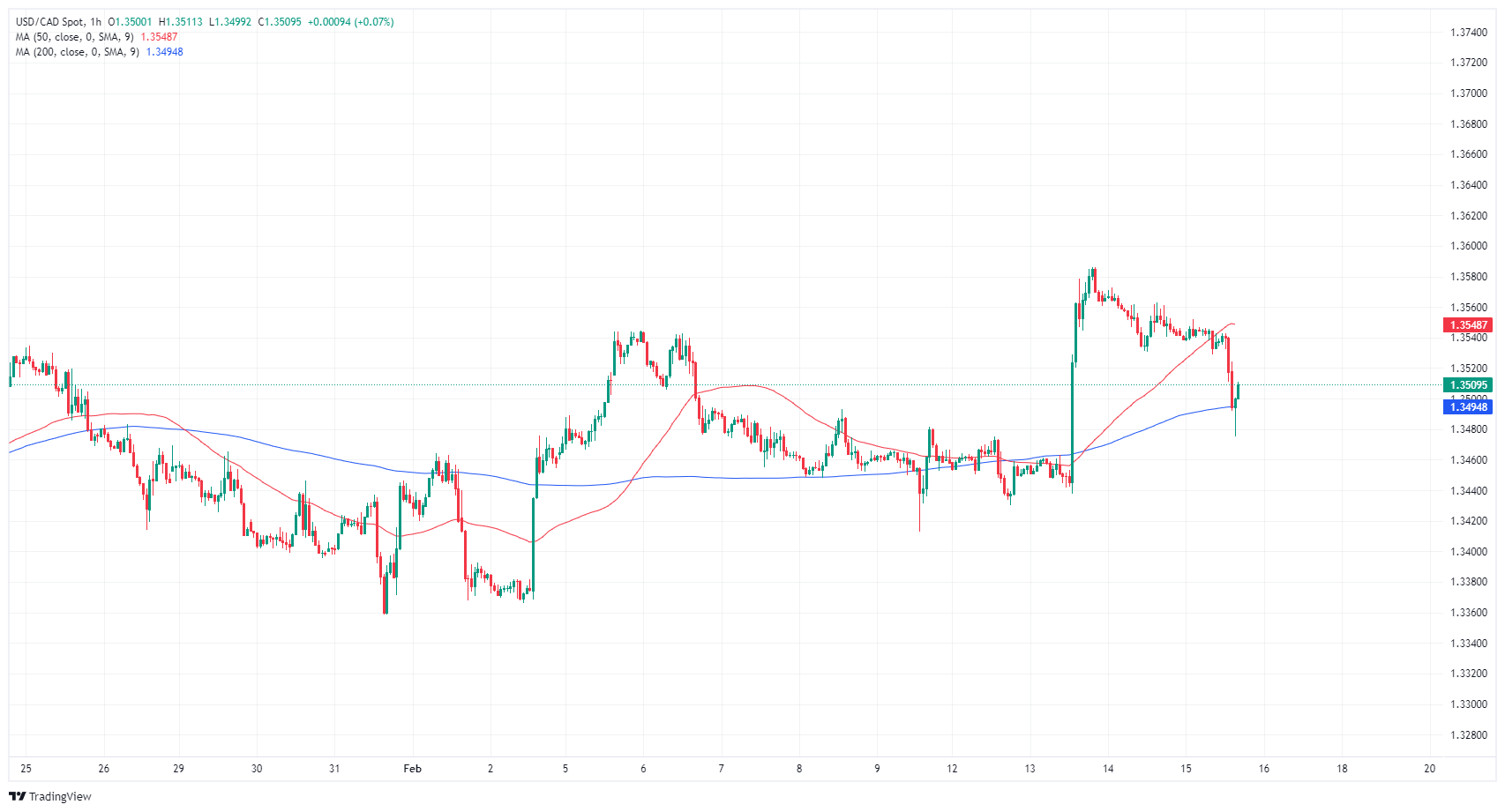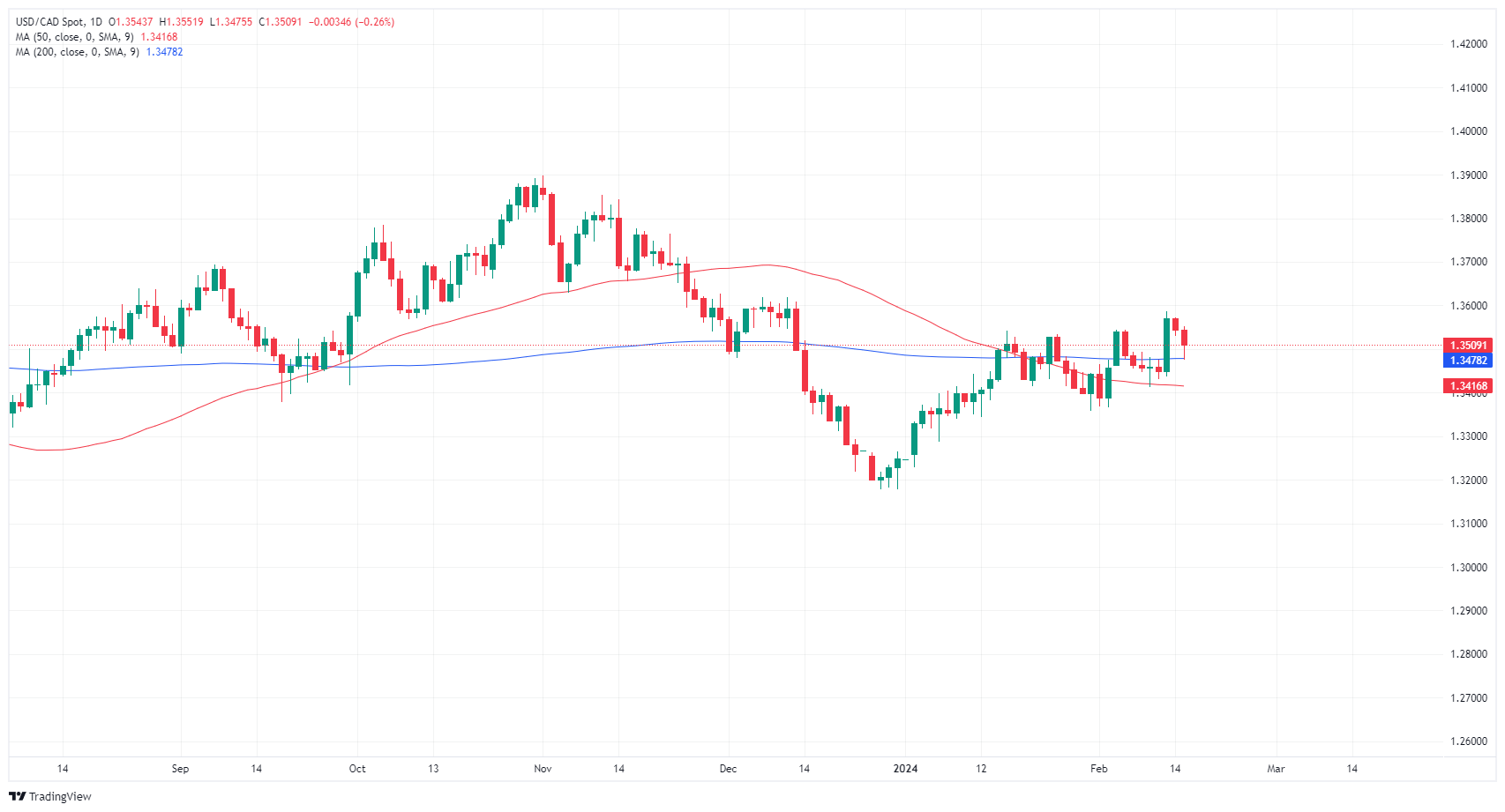- The Canadian dollar recovers ground after the publication of US data.
- In Canada, low impact data is expected for the second half of the trading week.
- Crude oil markets in recovery mode, supporting the Canadian Dollar.
The Canadian Dollar (CAD) managed to advance against the US Dollar (USD) on Thursday after US retail sales missed expectations and contracted in January. The Dollar's mid-week rally, due to CPI-fueled Risk Aversion, is tapering, and the CAD is finding additional support in recovering crude oil supplies heading into the end of the trading week. .
The number of housing starts in Canada was below expectations, but this data of little impact had little movement in the markets, as investors generally focus on the changes in the US data. The rebound in crude oil also boosted the Canadian dollar.
Daily Market Summary: Falling US Retail Sales Led to Dollar Weakness on Thursday
- US retail sales fell 0.8% in January, well below the -0.1% forecast.
- US Retail Sales for December were revised downward from 0.6% to 0.4%.
- US retail sales excluding autos also fell 0.6% month-on-month in January versus the forecast of 0.2%.
- US Industrial Production for January also fell 0.1% mom versus the forecast of 0.3%, adding to December's 0.0% (revised from 0.1%).
- Initial claims for unemployment benefits in the United States stood at 212,000 compared to the 220,000 expected for the week ending February 9, while the previous week they were revised from 218,000 to 220,000.
- The number of housing starts in Canada stood at 223,600 in January, compared to the expected 235,000, which represents an even greater decrease compared to the 248,900 of the previous period (revised downwards from 249,300).
- Crude oil markets made a strong recovery on Thursday after Wednesday's sharp decline.
- The barrel of US West Texas Intermediate (WTI) crude oil once again surpassed $77.00, eventually testing $77.50 during the US trading session.
- Friday will conclude the week with the publication of the Producer Price Index (PPI) and the Michigan Consumer Sentiment Index.
- The US PPI for the year ended January is expected to fall from 1.8% to 1.6%.
- The Michigan Consumer Sentiment Index for February is expected to improve slightly to 80.0 from 79.0.
Current rate of the Canadian dollar
Below is the percentage change of the Canadian Dollar (CAD) against the currencies listed today. The Canadian Dollar was the strongest currency against the US Dollar.
| USD | EUR | GBP | CAD | AUD | JPY | NZD | CHF | |
| USD | -0.24% | -0.07% | -0.26% | -0.16% | -0.23% | -0.22% | -0.48% | |
| EUR | 0.23% | 0.15% | -0.04% | 0.07% | 0.00% | 0.01% | -0.24% | |
| GBP | 0.07% | -0.17% | -0.17% | -0.10% | -0.16% | -0.16% | -0.40% | |
| CAD | 0.26% | 0.02% | 0.20% | 0.09% | 0.03% | 0.02% | -0.21% | |
| AUD | 0.18% | -0.07% | 0.11% | -0.10% | -0.06% | -0.06% | -0.30% | |
| JPY | 0.23% | 0.00% | 0.15% | -0.04% | 0.05% | 0.00% | -0.24% | |
| NZD | 0.23% | -0.01% | 0.17% | -0.03% | 0.07% | 0.00% | -0.23% | |
| CHF | 0.47% | 0.24% | 0.40% | 0.21% | 0.31% | 0.24% | 0.24% |
The heat map shows the percentage changes of the major currencies against each other. The base currency is chosen in the left column, while the quote currency is chosen in the top row. For example, if you choose the euro in the left column and scroll down the horizontal line to the Japanese yen, the percentage change in the box will represent EUR (base)/JPY (quote).
Technical Analysis: The Canadian Dollar recovers ground against the Dollar
The Canadian Dollar (CAD) recovered about a quarter of a percentage point against the US Dollar on Thursday, while it gave up a quarter of a percentage point against the market's strongest currency of the day, the Swiss Franc (CHF). The US dollar has weakened in the second half of the week, which has favored the Canadian dollar.
USD/CAD hit an intraday low of 1.3475 on Thursday, and the pair is running into the short-term technical support of the 200-hour SMA near 1.3494, as bids battle the 1.3500 zone. .
Daily candles continue to see friction from the 200-day SMA at 1.3478. Despite USD/CAD constantly testing new highs, progress has been scant as the pair threatens to enter a consolidation pattern between 1.3400 and 1.3600.
USD/CAD hourly chart
USD/CAD Daily Chart
Frequently Asked Questions about the Canadian Dollar
What factors determine the price of the Canadian dollar?
The key factors that determine the price of the Canadian dollar (CAD) are the level of interest rates set by the Bank of Canada (BoC), the price of oil, Canada's main export product, the health of its economy, inflation and the trade balance, which is the difference between the value of Canadian exports and its imports. Other factors are market confidence, that is, whether investors bet on riskier assets (risk-on) or look for safe assets (risk-off), with the risk-on being positive for the CAD. As its largest trading partner, the health of the US economy is also a key factor influencing the Canadian dollar.
How do Bank of Canada decisions affect the Canadian dollar?
The Bank of Canada (BoC) exerts significant influence over the Canadian Dollar by setting the level of interest rates that banks can lend to each other. This influences the level of interest rates for everyone. The BoC's main objective is to keep inflation between 1% and 3% by adjusting interest rates up or down. Relatively high interest rates are usually positive for the CAD. The Bank of Canada can also use quantitative easing and tightening to influence credit conditions, with the former being negative for the CAD and the latter being positive for the CAD.
How does the price of oil affect the Canadian dollar?
The price of oil is a key factor influencing the value of the Canadian Dollar. Oil is Canada's largest export, so the price of oil tends to have an immediate impact on the value of the CAD. Generally, if the price of oil rises, the CAD also rises, as aggregate demand for the currency increases. The opposite occurs if the price of oil falls. Higher oil prices also tend to lead to a higher probability of a positive trade balance, which also supports the CAD.
How does inflation data influence the value of the Canadian Dollar?
Although inflation has traditionally always been considered a negative factor for a currency, as it reduces the value of money, the opposite has actually happened in modern times, with the relaxation of cross-border capital controls. Higher inflation often leads central banks to raise interest rates, attracting more capital inflows from global investors looking for a lucrative place to store their money. This increases the demand for the local currency, which in the case of Canada is the Canadian Dollar.
How does economic data influence the value of the Canadian dollar?
The published macroeconomic data measures the health of the economy and may have an impact on the Canadian dollar. Indicators such as GDP, manufacturing and services PMIs, employment and consumer confidence surveys can influence the direction of the CAD. A strong economy is good for the Canadian dollar. Not only does it attract more foreign investment, but it may encourage the Bank of Canada to raise interest rates, resulting in a stronger currency. However, if economic data is weak, the CAD is likely to fall.
Source: Fx Street
I am Joshua Winder, a senior-level journalist and editor at World Stock Market. I specialize in covering news related to the stock market and economic trends. With more than 8 years of experience in this field, I have become an expert in financial reporting.







